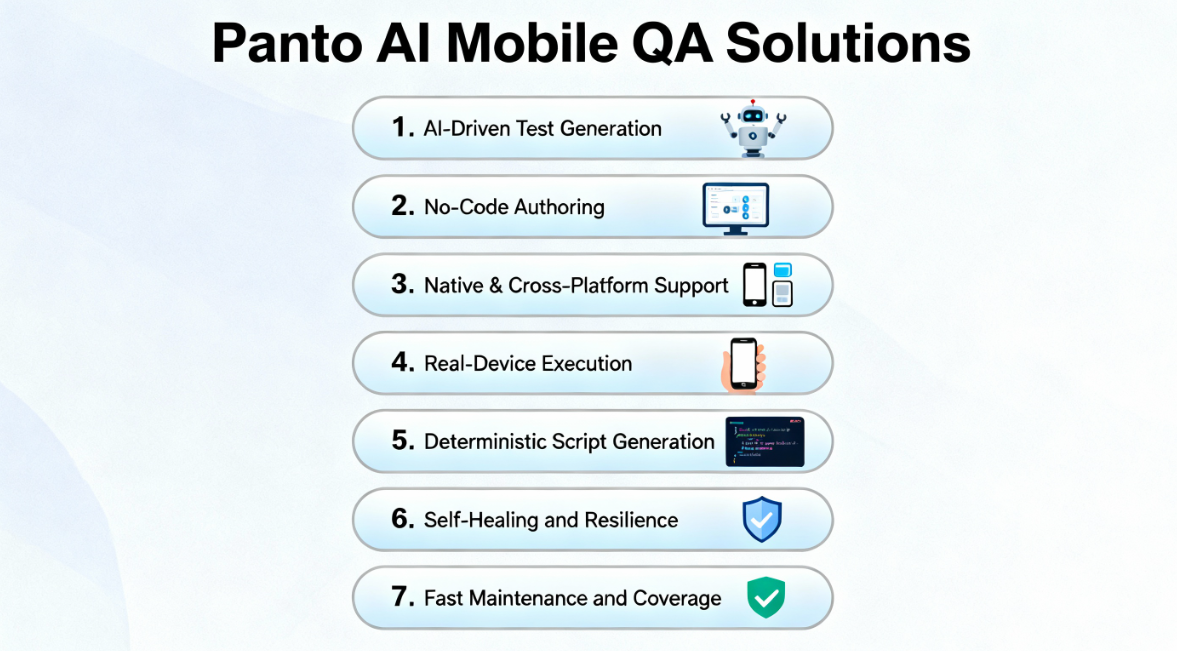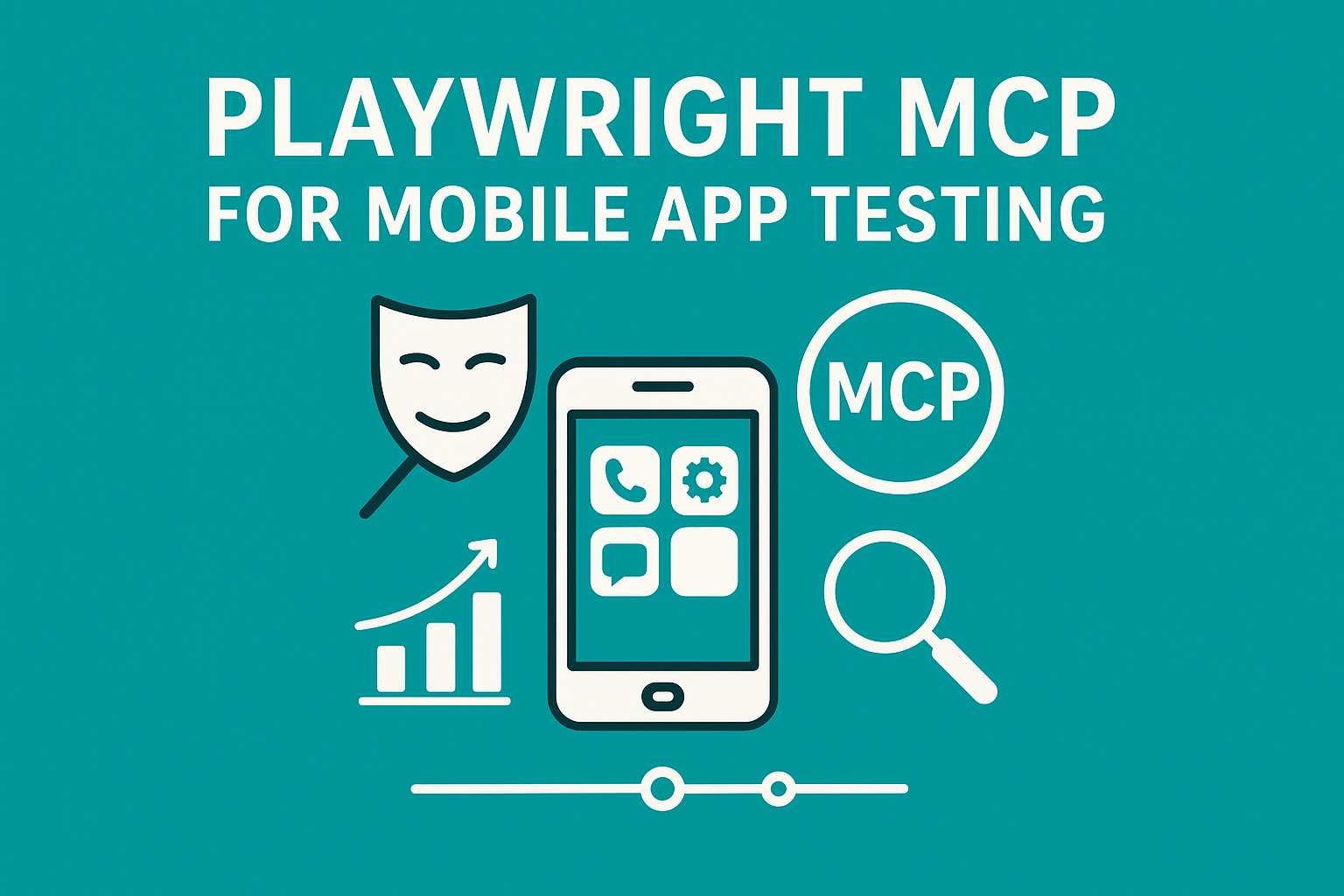The landscape of software testing is rapidly evolving, demanding faster feedback and broader coverage. Consequently, mobile QA presents unique challenges to its teams, due to rapid development cycles and device variety.
Moreover, modern QA automation tools and artificial intelligence are reshaping mobile testing. This shift moves toward intelligent, context-aware automation. In particular, the combination of Playwright and the Model Context Protocol (MCP) represents a significant step forward.
In this article, we examine how Playwright MCP can be leveraged for mobile application testing, delving into core capabilities and practical implications.
Playwright and MCP : Deep Dive
The Foundation: Playwright MCP for Mobile Testing
Playwright is an open-source automation framework popular for its speed, reliability, and cross-browser capabilities. Designed to automate web browsers, it offers a single API for testing across Chromium, Firefox, and WebKit. Furthermore, its utility extends into the mobile domain through emulation and specialized support.
Playwright’s Core Strengths in Mobile Contexts

Playwright’s robust architecture addresses common web automation pain points. As a result, this design translates directly into benefits for mobile testing scenarios. Its ability to reliably wait for elements and handle dynamic content is a major advantage.
Device Emulation for Responsive Design
Playwright’s comprehensive device emulation is a key feature for mobile debugging. It allows testers to simulate a wide range of mobile environments directly within a desktop browser. Thus, it becomes crucial for verifying the responsiveness and layout of web applications on mobile screens.
Emulation settings allow for precise control over key mobile characteristics:
- Viewport size and device pixel ratio.
- User agent string definition.
Additionally, pre-configured device presets cover popular smartphones and tablets, simplifying the setup. This focus on configuration over complex infrastructure is a key differentiator.
Native Support for Mobile Web Views
Beyond simple emulation, Playwright offers powerful support for automating web content within native mobile environments. This is relevant for hybrid applications that embed web views, allowing direct interaction with web components inside a mobile app.
For example, Playwright can connect to and control Chrome on Android devices and emulators. This enables unified tests for the web portion of hybrid mobile applications, bridging the gap with traditional web testing.
Ultimately, this specialized support ensures the quality of embedded web experiences, providing reliable, fast automation within the confines of a mobile application’s web view.
Unified API for Cross-Platform Testing
The single, consistent API across different browser engines and mobile contexts is a major productivity booster. Testers avoid learning separate APIs for desktop web, mobile emulation, and Android web views, reducing learning curve and maintenance overhead.
Consequently, this unified approach facilitates truly cross-platform test suites. A single test script can be adapted with minimal changes to run against various environments, which is paramount in modern DevOps pipelines.
The API design emphasizes modern web standards and asynchronous operations. Therefore, tests are less prone to flakiness and more representative of real user interactions.
The Mobile Testing Challenge: Native vs. Web
It is important to define the scope of Playwright’s mobile capabilities. Playwright excels at testing web content, whether emulated or in an Android web view. However, it is not a dedicated tool for native mobile application testing.
Native mobile testing involves interacting with OS elements and controls outside the web view. Tools like Appium are traditionally used for this. This is where the Model Context Protocol begins to offer a path forward.
Playwright’s native mobile limitations necessitate a hybrid strategy for full-stack mobile application testing. Ideally, the solution combines Playwright’s web strengths with a mechanism to handle the native parts seamlessly.
Introducing the Model Context Protocol (MCP)
The Model Context Protocol (MCP) is a concept emerging from the intersection of large language models (LLMs) and software automation. It is a standardized way for AI models to interact with and understand the context of a user interface. In essence, this protocol aims to make automation more intelligent and less reliant on brittle, hard-coded selectors.
The Core Concept of Contextual Automation
MCP is fundamentally about providing a rich, structured representation of the application’s state to an external model. This representation goes beyond simple HTML or DOM structure, including semantic information, visual layout, and the current user intent.
In turn, the protocol acts as an intermediary layer between the automation framework and the AI. It translates the complex, dynamic state of the application into a format an LLM can easily process and reason about, enabling intelligent decisions.
Ultimately, this contextual awareness is a game-changer for test automation. Instead of manually coding a selector, the AI can be instructed to “click the login button,” and the MCP server provides the necessary context for locating the element.
How MCP Works with Automation Tools
An MCP server typically sits alongside the automation tool, such as Playwright. The server captures the current state of the application under test and formats it according to the protocol’s specification.
Afterward, the formatted context is sent to an LLM, which acts as the decision-making engine. The LLM processes the context and the high-level test instruction, returning a structured action.
The automation tool, Playwright, receives the structured action from the MCP server. It then executes the command against the application, effectively closing the loop. Thus, this creates a powerful, AI-powered testing workflow.
Benefits of MCP in Testing
The integration of MCP brings several compelling benefits to the debugging process, most significantly increased test resilience and reduced maintenance overhead.
1. Increased Test Resilience:
- AI-driven element location is more robust than traditional selectors.
- The model can infer the correct element even if its ID or class changes.
- Consequently, test failures caused by minor UI updates become less frequent.
2. Reduced Maintenance Overhead:
- Tests are written in natural, high-level language, focusing on user intent.
- Changes to the underlying application structure require fewer updates.
- Therefore, the AI handles low-level details of element interaction.
3. Faster Test Creation:
- Testers focus on business logic rather than selectors.
- Often, the AI can generate initial automation steps from a simple description.
The Playwright MCP Synergy
When Playwright and MCP are combined, they create a formidable automation environment. Playwright provides the reliable, fast execution engine, while MCP injects contextual intelligence. Together, they form a powerful solution for testing complex, dynamic web applications accessed on mobile devices.
Playwright’s ability to capture full page state—DOM, visual snapshots, network activity—makes it an ideal data source for MCP. Because of this, the LLM can make more accurate decisions.
Leveraging Playwright MCP for Mobile App Testing

The true potential of the Playwright-MCP combination lies in its ability to handle the web-centric parts of the mobile experience with unprecedented intelligence. As a result, it revolutionizes testing for hybrid and mobile web applications.
Intelligent Mobile Web Automation
For mobile web or web view–reliant applications, the Playwright MCP stack offers a superior debugging experience. Notably, the AI-driven approach overcomes challenges like dynamic layouts and complex gestures.
Handling Dynamic Mobile Layouts
Mobile web layouts are highly dynamic, adapting to different screen sizes and orientations. Traditional debugging scripts struggle under these conditions.
By contrast, MCP interprets visual and semantic context. It identifies elements like the “checkout button” regardless of position.
Advanced Gesture Simulation in Emulation
Playwright supports complex interactions like hovering, dragging, and touch events. With MCP, the AI can translate high-level gestures into precise actions.
For example, “swipe the carousel to the left” becomes the exact touch sequence via MCP. Consequently, testers no longer need to calculate manual coordinates.
The Hybrid Testing Strategy with MCP
For applications with both native and web components, a hybrid strategy is most effective. Playwright MCP handles the web portions, and a native tool handles the rest. Meanwhile, MCP orchestrates the combined flow.
Orchestrating Native and Web Flows
The MCP server can be extended to communicate with native automation tools like Appium.
- If the context is a web view: generate a Playwright action.
- If the context is a native screen: generate an Appium action.
Accordingly, a unified test script can describe the entire user journey.
Seamless Context Transition
The key challenge in hybrid testing is transitioning between native and web environments. MCP maintains continuous, high-level application context, enabling seamless transitions.
As a result, testers can validate complex user journeys involving frequent environment switching.
Future Outlook: Full Mobile Context
While the current Playwright MCP synergy is primarily web-focused, the Model Context Protocol points toward a future of full-stack mobile QA. Eventually, the protocol could expand to cover native UI trees.
Panto AI: Bridging the Native Gap

The limitations of Playwright have led to the emergence of specialized tools like Panto AI. Panto is designed to address full-spectrum mobile QA, including native application testing—a key challenge for the Playwright MCP approach.
It extends context-aware automation by incorporating native hooks, enabling interactions beyond the web view and supporting unified end-to-end mobile testing.
How Panto AI Solves The Broken Mobile QA Problem

1. AI-Driven Test Generation
Panto’s AI agent interprets scenarios and instructions in plain language, mapping test flows with computer vision and NLP. This process speeds up test authoring—no manual scripting needed.
2. No-Code / Codeless Authoring
Panto gives users a visual dashboard and accepts natural-language instructions, making automation codeless for QA teams. Describe a scenario, and the platform builds the executable test automatically.
3. Native & Cross-Platform Support
Panto is tailored for mobile-first apps, supporting native iOS, Android, and major cross-platform frameworks like React Native and Flutter. Unlike Playwright, it directly hooks into native mobile elements for robust interaction.
4. Real-Device Execution and Integration
Panto integrates with real-device clouds like BrowserStack and LambdaTest, plus on-prem farms. It runs AI-powered tests across hundreds of devices in parallel and triggers mobile regression from CI/CD pipelines automatically.
5. Deterministic Script Generation
Although Panto is codeless for users, it produces deterministic scripts that can be exported and reviewed in formats like Appium or Maestro—ensuring full test transparency.
6. Self-Healing and Resilience
Panto features AI-powered self-healing—when UI changes or test failures happen, it attempts recovery and logs all actions for audit. This reduces flakiness and manual maintenance.
7. Fast Maintenance and Coverage
Panto uses continuous learning so its AI can regenerate or update tests as your app evolves, slashing maintenance time—often by more than 30%.
Implementing Playwright MCP: Practical Steps
Adopting Playwright MCP requires planning, environment setup, MCP integration, and switching to intent-based testing.

1. Setting Up the Environment
Install Playwright and configure mobile emulation or Android support. Ensure the execution layer is working before adding AI.
2. Playwright Installation and Configuration
Install Playwright with browser drivers. For Android, install Playwright’s Android dependencies.
Configure device presets with viewport and user agent settings.
3. MCP Server Integration
The MCP server is the bridge between Playwright and the LLM. It:
- Collects Playwright page context
- Formats context for the LLM
- Sends/receives LLM decisions
- Outputs executable Playwright actions
Often, this is done via a plugin or library.
4. Designing Intent-Based Tests
The biggest shift: test creation based on user intent, not selectors.
Examples:
- “Navigate to the product page and add the first item to the cart.”
- “Complete checkout using the saved payment method.”
- “Verify that the mobile menu contains ‘My Account.’”
5. Leveraging Contextual Feedback
Instead of generic errors, LLMs can return actionable explanations, such as conflicting element labels or ambiguous instructions.
Challenges and Considerations
Despite its promise, Playwright MCP comes with considerations.
LLM Dependency and Cost
Relying on LLMs introduces:
- Latency
- API pricing
- Dependency on model performance
Optimizing context is key.
The Native Mobile Gap
True end-to-end native mobile QA still requires an additional tool for now. Playwright MCP is ideal for teams focused on mobile web and hybrid applications.
Conclusion: The Future of Intelligent Mobile QA
The integration of Playwright and MCP marks a major evolution in mobile QA. This combination advances beyond brittle scripts toward intelligent, context-aware automation.
Key Takeaways
- Resilience: AI element detection reduces flakiness
- Efficiency: Unified API + intent-based scripts accelerate testing
- Scope: Strong coverage for mobile web and hybrid apps
Playwright MCP makes mobile web testing faster, smarter, and more inclusive.
- AI handles selectors, test-writing, and recovery.
- Teams keep pace with rapid UI changes.
- Maintenance demands plunge.
- Releases speed up.
Limitations exist for fully native apps. Use MCP for mobile web, and pair with native tools like Appium or comprehensive platforms like Panto AI for complete coverage.
Strategic use of Playwright MCP improves test reliability, increases team collaboration, and delivers enterprise-grade mobile test automation.





